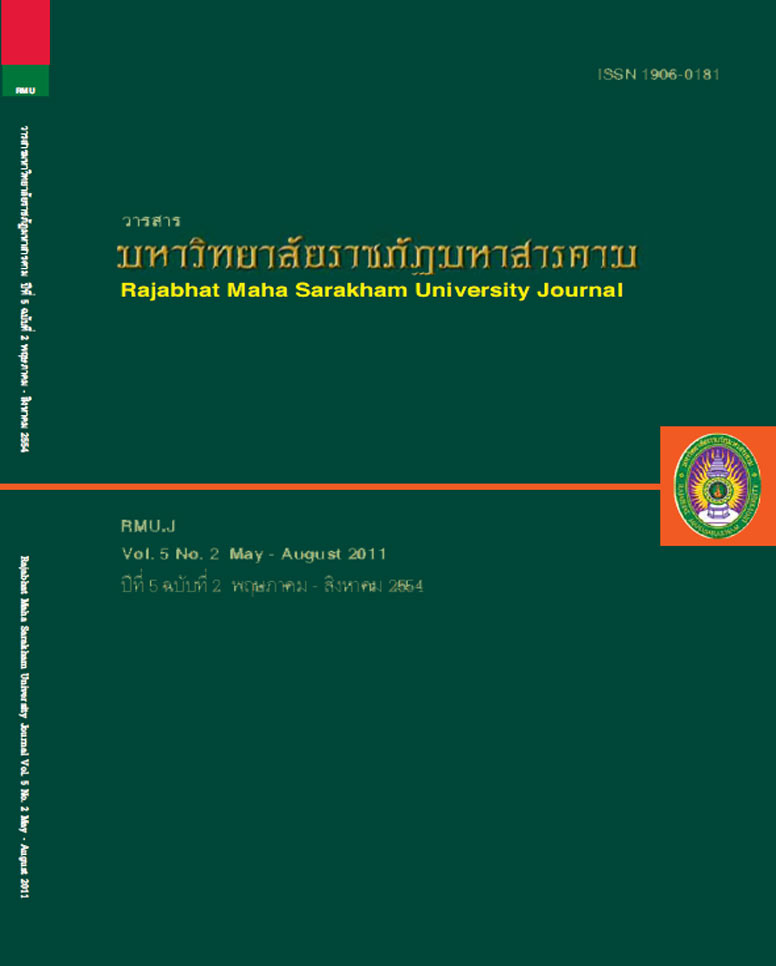รูปแบบการจัดการการขนส่ง โดยการประยุกต์ใช้ขั้นตอนวิธีเชิงพันธุกรรม : กรณีศึกษาบริษัทขายวัสดุก่อสร้าง; A Transportation Management Model Using the Application of Genetic Algorithms (GAs): A Case Study of Construction Material Company
Main Article Content
บทคัดย่อ
งานวิจัยนี้มีวัตถุประสงค์ ประการแรก เพื่อศึกษาเส้นทางที่สั้นที่สุดในการขนส่งวัตถุดิบให้กับลูกค้า และ ประการที่สอง
สร้างรูปแบบการจัดการการขนส่งของกรณีศึกษาที่เป็นบริษัทขายวัสดุก่อสร้าง จากการวิเคราะห์ปัญหาในการขนส่งของกรณีศึกษา
ด้วยแผนภาพสาเหตุและผล ผลการวิจัยพบว่า
การจัดเส้นทางที่ไม่มีประสิทธิภาพเป็นสาเหตุหลักในการจัดการการขนส่งของกรณีศึกษา ซึ่งปัญหาการจัดเส้นทางการ
ขนส่งดังกล่าวเป็นปัญหาแบบ Traveling Salesman Problem (TSP) โดยในงานวิจัยนี้ได้ทำการเปรียบเทียบประสิทธิภาพ
ของขั้นตอนวิธี (Algorithms) ในการหาเส้นทางที่สั้นที่สุดของปัญหา TSP ทั้งหมด 4 วิธี คือ วิธีแบบละโมบ (Greedy
algorithms) วิธี Saving Algorithms วิธี Nearest Algorithms และวิธีเชิงพันธุกรรม (Genetic algorithms, GAs)
จากการเปรียบเทียบพบว่า ขั้นตอนวิธีเชิงพันธุกรรมสามารถหาเส้นทางที่สั้นที่สุดได้ โดยมีระยะทางรวมเป็น 61.4 กิโลเมตร
ซึ่งลดระยะทางรวมลงจากเดิม 19.8 กิโลเมตร หรือลดลงร้อยละ 24.38 ดังนั้นจึงได้นำวิธีการ GAs มาสร้างเป็นโปรแกรม
สำหรับหาเส้นทางที่สั้นที่สุดในการขนส่งวัสดุก่อสร้างของกรณีศึกษา โปรแกรมเขียนด้วยภาษา C+ ที่พัฒนาขึ้นบน Windows
application จึงง่ายต่อการใช้งานและช่วยให้พนักงานสามารถจัดเส้นทางการขนส่งได้อย่างมีประสิทธิภาพ
The objectives of this research were to find the shortest path for construction material transportation
to the customers and create a transportation management model for the targeted construction material
company. According to an analysis of the cause-effect diagram to identify transportation problems in
the targeted company, the results revealed as follows:Inefficient routing management problem was the main cause in the transportation problem of this
case study which was identified as the Traveling Salesman Problem (TSP). The research was conducted
to find out the shortest transportation path by comparing four methods in terms of efficiency and algorithms;
namely, Greedy Algorithms, Saving Algorithms, Nearest Algorithms, and Genetic Algorithms (GAs). The
result showed that GAs performed the best solution. GAs took the shortest distance of 61.4 kilometers
with a reduction of 19.8 kilometers (or 24.38%) from the original distance. Thus, the GAs was selected to
create a computer program to find the shortest path for material transportation of the company, using the
C+ language program developed for Windows application with simple user interface. The program was
an effectient tool for the operators to arrange the transportation routes.
Article Details
1. บทความที่ลงตีพิมพ์ทุกเรื่องได้รับการตรวจทางวิชาการโดยผู้ประเมินอิสระ ผู้ทรงคุณวุฒิ (Peer Review) สาขาที่เกี่ยวข้อง อย่างน้อย 3 ท่าน ในรูปแบบ Double blind review
2. ข้อคิดเห็นใด ๆ ของบทความที่ลงตีพิมพ์ในวารสารมหาวิทยาลัยราชภัฏมหาสารคาม นี้เป็นของผู้เขียน คณะผู้จัดทำวารสารไม่จำเป็นต้องเห็นด้วย
3. กองบรรณาธิการวารสารมหาวิทยาลัยราชภัฏมหาสารคาม ไม่สงวนสิทธิ์การคัดลอกแต่ให้อ้างอิงแสดงที่มา


